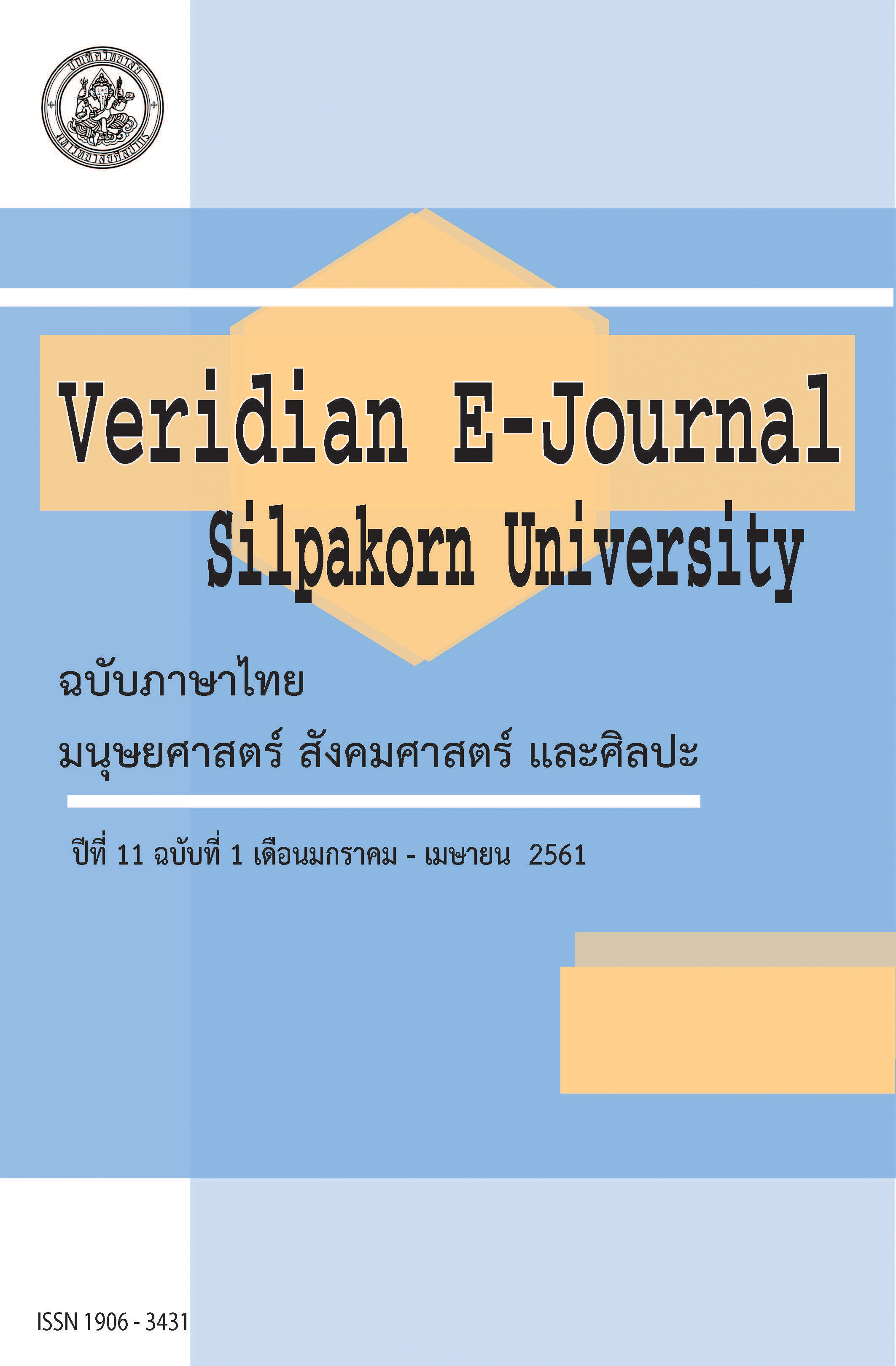การอนุรักษ์และสร้างสรรค์หัตถกรรมจักสานของศูนย์ส่งเสริมฝีมือจักสานด้วยไม้ไผ่ ในอำเภอพนัสนิคม จังหวัดชลบุรี (The Wickerwork’s Creative and Conservation of Traditional Bamboo Handicraft Center in Phanat Nikhom, Chonburi Province)
Main Article Content
Abstract
การดำรงอยู่ของชุมชนผลิตหัตถกรรมจักสานในประเทศไทยมีจำนวนลดน้อยลง เนื่องจากหลายปัจจัย โดยเฉพาะการพัฒนาระบบเศรษฐกิจและกิจการงานอุตสาหกรรมของประเทศ ทำให้ชุมชนผลิตหัตถกรรมจักสานในหลายท้องที่ของประเทศไทยไม่สามารถปรับตัวเองได้จนต้องสลายกลุ่มของตนไป
บทความนี้มีวัตถุประสงค์เพื่อนำเสนอแนวทางการปรับตัวด้วยวิธีการอนุรักษ์และการสร้างสรรค์ผลิตภัณฑ์หัตถกรรมจักสานของศูนย์ส่งเสริมฝีมือจักสานด้วยไม้ไผ่ อำเภอพนัสนิคม จังหวัดชลบุรีโดยมีการเก็บข้อมูลด้วยวิธีการสัมภาษณ์ และการสังเกตการดำเนินงานของศูนย์ส่งเสริมฝีมือจักสานด้วยไม้ไผ่ ร่วมกับการรวบรวมข้อมูลเชิงเอกสาร และภาพถ่าย โดยข้อมูลที่ได้รับถูกวิเคราะห์ด้วยการวิเคราะห์เชิงเนื้อหา (Content Analysis) และการจัดกลุ่มข้อมูล (Classification Analysis) ศูนย์ส่งเสริมฝีมือจักสานด้วยไม้ไผ่จัดตั้งเป็นกลุ่มผลิตหัตถกรรมจักสานแห่งแรกของอำเภอพนัสนิคมเมื่อปี พ.ศ. 2521 โดยการสนับสนุนของมูลนิธิส่งเสริม ศิลปาชีพ ศูนย์ฯ นี้มีบทบาทสำคัญในการส่งเสริมชาวบ้านในอำเภอพนัสนิคมให้สามารถผลิตหัตถกรรมจักสานจากไม้ไผ่ที่มีความประณีตและทันสมัยเพื่อสร้างมูลค่าเพิ่มให้กับผลิตภัณฑ์ รวมถึงการสร้างเครือข่ายการผลิตของศูนย์ฯ อยู่ทั่วอำเภอพนัสนิคม ที่พร้อมผลิตงานหัตถกรรมจักสานเพื่อส่งจำหน่ายให้กับมูลนิธิศิลปาชีพ เป็นรายได้ของครอบครัว นอกเหนือจากการทำไร่ทำนาสืบมาจากการศึกษาพบว่าศูนย์ส่งเสริมฝีมือจักสานด้วยไม้ไผ่ในปัจจุบันมีการพัฒนาระบบบริหารจัดการผลิตและการตลาดในแบบสมัยใหม่ เช่น การสร้างเครือข่ายเพื่อกระจายงานให้ผลิตตามความชำนาญของช่าง การพัฒนาเครื่องมือเครื่องจักรมาช่วยทุ่นแรง การพัฒนารูปแบบผลิตภัณฑ์หัตถกรรมจักสานให้เหมาะสมกับความต้องการของลูกค้า การพัฒนาระบบการตลาดและการขนส่งสินค้า และการเผยแพร่ภูมิปัญญาการทำหัตถกรรมจักสานให้แก่ประชาชนผู้สนใจโดยหวังการสืบทอดภูมิปัญญาหัตถกรรมจักสานไม้ไผ่ของท้องถิ่นต่อไป ซึ่งนับเป็นตัวอย่างในการปรับตัวด้านการอนุรักษ์และสร้างสรรค์ผลงานหัตถกรรมจักสานแก่ชุมชนอื่นๆ ให้สามารถนำไปประยุกต์ใช้ต่อไป
The existence of handicraft wickerwork community in Thailand has decreased due to numbers of factors; especially Thai economic and industrialization development which affected wickerwork handicraft communities in many areas of Thailand could not adapt themselves to such change and finally disappeared.
This article aimed to propose self-adaptation method by preserving and creating handicrafts products introduced by Traditional Bamboo Handicraft Center located in Phanat Nikhom District, Chonburi Province. Data collection methods were interviewing, observing the operation of Traditional Bamboo Handicraft Center and collecting documentation data and photographs. Content analysis and classification analysis method were applied to analyze the data. Traditional Bamboo Handicraft Center was established in 1978 as the first bamboo wickerwork handicrafts community in Phanat Nikhom district, supported by The Foundation for the Promotion of Supplementary Occupations and Related Techniques of Her Majesty Queen Sirikit of Thailand which influenced on encouraging local people in Phanat Nikhom to produce beautiful and trendy bamboo wickerwork handicraft products for value added. Also, the network of the handicraft productions was spreading throughout Phanat Nikhom District to make bamboo handicrafts products and distribute to The Foundation for the Promotion of Supplementary Occupations and Related Techniques of Her Majesty Queen Sirikit of Thailand for sale to earn revenue in addition to agricultural professions.
The results of this study indicated that Traditional Bamboo Handicraft Center has developed production management and marketing system so that the work processes were up-to-date, for example, making connection to distribute crafts work in accordance with skills of people, developing tools and machines to facilitate work, improving bamboo wickerwork handicrafts forms and products to meet the customers’ requirement, developing marketing and transportation system and propagating local wisdom of bamboo wickerwork handicrafts to people who are interested. Bamboo wickerwork handicrafts, the local wisdom, was hoped to be passed on to the younger generation. This is a good example of self-adaptation by preserving and creating bamboo wickerwork handicrafts products which other community could apply to their lives.
